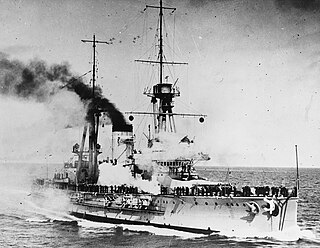
The Battle of Cape Palos, also known as the Second Battle of Cape Palos, was the biggest naval battle of the Spanish Civil War, fought on the night of March 5–6, 1938, east of Cape Palos near Cartagena, Spain.
The Battle of Cape Spartel was a naval battle of the Spanish Civil War that broke the Republican blockade of the Strait of Gibraltar, securing the maritime supply route to Spanish Morocco for the Nationalists early in the war. The action occurred on 29 September 1936 between two Nationalist cruisers and two Republican destroyers.

Alfonso XIII was the second of three España-class dreadnought battleships built in the 1910s for the Spanish Navy. Named after King Alfonso XIII of Spain, the ship was not completed until 1915 owing to a shortage of materials that resulted from the start of World War I the previous year. The España class was ordered as part of a naval construction program to rebuild the fleet after the losses of the Spanish–American War; the program began in the context of closer Spanish relations with Britain and France. The ships were armed with a main battery of eight 305 mm (12 in) guns and were intended to support the French Navy in the event of a major European war.

The Churruca class was a Spanish destroyer class built for the Spanish Navy based on a British design. Eighteen ships were built, with two being sold to Argentina and commonly referred to as the Cervantes class. The last two members of the class are sometimes referred to as a separate class, the Alava class.

Sánchez Barcáiztegui was a Churruca-class destroyer of the Spanish Republican Navy. She took part in the Spanish Civil War on the side of the government of the Second Spanish Republic.

Almirante Ferrándiz was a Churruca-class destroyer in the Spanish Republican Navy. She took part in the Spanish Civil War on the government side.

Lepanto was a Churruca-class destroyer of the Spanish Republican Navy. She took part in the Spanish Civil War on the side of the government of the Second Spanish Republic. She was named after the Battle of Lepanto.

Júpiter-class minelayers was a group of four vessels of the Spanish Republican Navy built during the Spanish Republic. Three of them came into service during the Civil War after joining the rebel side.

José Luis Díez was a Churruca-class destroyer in the Spanish Republican Navy. She took part in the Spanish Civil War on the government side.

Almirante Cervera was a light cruiser and lead ship of the Almirante Cervera class of the Spanish Navy. She was named after the Spanish admiral Pascual Cervera y Topete, commander of the Spanish naval forces in Cuba during the Spanish–American War. She was part of the Spanish Republican Navy between 1931 and 1936, year in which she became a key player of the Nationalist Fleet in the Spanish Civil War.

Baleares was a Canarias-class heavy cruiser of the Spanish Navy whose control was taken by the Nationalist side during the Spanish Civil War. The two ships of the class were built upon a British design and were a modified version of the Royal Navy′s County class. Baleares was constructed in Spain by the Vickers-Armstrongs subsidiary Sociedad Española de Construcción Naval, and saw service during the Spanish Civil War, when she was torpedoed and sunk by destroyers of the Spanish Republican Navy during the Battle of Cape Palos.

Mar Negro was an armed merchantman of the Nationalist Spanish Navy during the Spanish Civil War. The cargo ship was launched in 1930 along with her sister ship MV Mar Cantábrico, and after five years with the Compañía Marítima Del Nervión company, she was first requisitioned by the Spanish Republican Navy in 1936. Captured by a group of Nationalist sympathizers from her crew off Algeria in 1937, she entered in service in 1938 after being converted to an auxiliary cruiser.

The Convoy de la Victoria was a Spanish naval battle on 5 August 1936 in the Strait of Gibraltar during the Spanish Civil War, between the escort of a Nationalist convoy and the Republican Navy destroyer Alcalá Galiano.

The Cartagena uprising took place 4–7 March 1939 during the Spanish Civil War. The troop transport SS Castillo de Olite was sunk during the revolt.

The Spanish Republican Navy was the naval arm of the Armed Forces of the Second Spanish Republic, the legally established government of Spain between 1931 and 1939.

Miguel Buiza Fernández-Palacios was a Spanish Navy officer best known for being the commander of the Spanish Republican Navy during the Spanish Civil War. He died in exile in Marseille in 1963.

The Laureate Badge of Madrid was the highest military award for gallantry of the Second Spanish Republic. It was awarded in recognition of action, either individual or collective, to protect the nation and its citizens in the face of immediate risk to the bearer or bearers' life. Those eligible were members of the Spanish Republican Armed Forces and testimonies of reliable witnesses were checked prior to concession.

Luis González de Ubieta y González del Campillo was an admiral of the Spanish Republican Navy during the Spanish Civil War. He died in exile as the captain of the Panamanian merchant vessel Chiriqui, refusing to be rescued when the ship under his command sank in the Caribbean Sea not far from Barranquilla.
Almirante Miranda (AM) was a Churruca-class destroyer that fought in the Spanish Civil War on the Republican side and, after the war, joined the post-war Spanish Navy. She was named after Admiral Augusto Miranda y Godoy, a Spanish Minister of the Navy.

Miguel de Cervantes was an Almirante Cervera-class light cruiser that served in the Spanish Navy. She fought in the Spanish Civil War on the Republican side, before joining the post-war Spanish Navy. She was ordered by a Royal Decree on 31 March 1926, as part of a naval construction project headed by Counter Admiral Honorio Cornejo.















